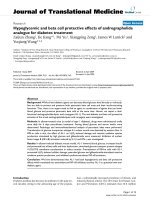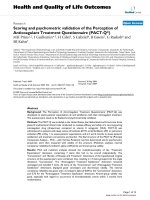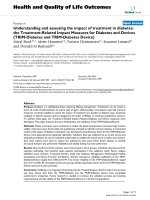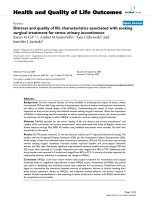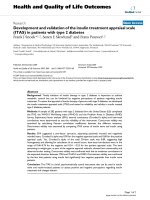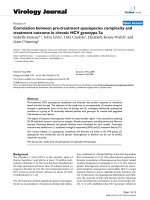báo cáo hóa học:" Psychotrauma and effective treatment of post-traumatic stress disorder in soldiers and peacekeepers" pot
Bạn đang xem bản rút gọn của tài liệu. Xem và tải ngay bản đầy đủ của tài liệu tại đây (280.79 KB, 7 trang )
BioMed Central
Page 1 of 7
(page number not for citation purposes)
Journal of Occupational Medicine
and Toxicology
Open Access
Review
Psychotrauma and effective treatment of post-traumatic stress
disorder in soldiers and peacekeepers
Karin Vitzthum*
1,2
, Stefanie Mache
1
, Ricarda Joachim
3
, David Quarcoo
1
and
David A Groneberg
1
Address:
1
Institute of Occupational Medicine, Charité-Universitätsmedizin Berlin, Free University Berlin and Humboldt-University Berlin,
Thielallee 69-73, D-14195 Berlin, Germany,
2
Department of Respiratory Medicine, Hanover Medical School, Carl-Neuberg-Straße 1, 30625
Hanover, Germany and
3
Center of Occupational Medicine, Charité-Universitätsmedizin Berlin, Free University Berlin and Humboldt-University
Berlin, Augustenburger Platz 1, D-13353 Berlin, Germany
Email: Karin Vitzthum* - ; Stefanie Mache - ;
Ricarda Joachim - ; David Quarcoo - ; David A Groneberg -
* Corresponding author
Abstract
Psychotrauma occurs as a result to a traumatic event, which may involve witnessing someone's
actual death or personally experiencing serious physical injury, assault, rape and sexual abuse, being
held as a hostage, or a threat to physical or psychological integrity. Post-traumatic stress disorder
(PTSD) is an anxiety disorder and was defined in the past as railway spine, traumatic war neurosis,
stress syndrome, shell shock, battle fatigue, combat fatigue, or post-traumatic stress syndrome
(PTSS). If untreated, post-traumatic stress disorder can impair relationships of those affected and
strain their families and society. Deployed soldiers are especially at a high risk to be affected by
PTSD but often receive inadequate treatment. Reviews to date have focused only on a single type
of treatment or groups of soldiers from only one country. The aim of the current review was to
evaluate characteristics of therapeutic methods used internationally to treat male soldiers' PTSD
after peacekeeping operations in South Eastern Europe and the Gulf wars.
This systematic literature review returned results pertaining to the symptoms, diagnosis, timing and
effectiveness of treatment. Sample groups and controls were relatively small and, therefore, the
results lack generalizability. Further research is needed to understand the influence and unique
psychological requirements of each specific military operation on the internationally deployed
soldiers.
Introduction
Traumatic events can cause psychological trauma (figure
1). These traumatic events may be single (Type I Trau-
mata), continuous, or repetitive incidents (Type II Trau-
mata) that render inadequate one's ability to cope with
the resulting feelings [1]. The inability to cope may
become apparent weeks to years after the traumatic expe-
rience. The traumatic event may involve witnessing some-
one's actual death or personally experiencing serious
physical injury, rape and sexual abuse, being held hostage,
or a threat to physical or mental stability. This is especially
true for traumata during childhood. Physical harm,
though often a component of the traumatic event, is not
mandatory for the development of psychological trau-
Published: 30 July 2009
Journal of Occupational Medicine and Toxicology 2009, 4:21 doi:10.1186/1745-6673-4-21
Received: 23 June 2009
Accepted: 30 July 2009
This article is available from: />© 2009 Vitzthum et al; licensee BioMed Central Ltd.
This is an Open Access article distributed under the terms of the Creative Commons Attribution License ( />),
which permits unrestricted use, distribution, and reproduction in any medium, provided the original work is properly cited.
Journal of Occupational Medicine and Toxicology 2009, 4:21 />Page 2 of 7
(page number not for citation purposes)
mata [2]. Individuals subjected to prolonged periods of
extreme poverty or verbal abuse may also be traumatized
as a result. Natural disasters, such as earthquakes and vol-
canic eruptions, and other catastrophes, such as mass vio-
lence and military service during war and peacekeeping
missions can also cause psychological trauma. This paper
focuses on PTSD as a result of male military service during
gulf wars and peacekeeping operations in South Eastern
Europe. We excluded female and child soldiers and Viet-
nam veterans explicitly from this review to ensure the
highest level of comparability.
Post-traumatic stress disorder (PTSD) is classified as an
anxiety disorder (ICD-10 F 43,1, DSM IV 309.81), to
develop characteristic symptoms after traumatic exposure
and to constantly avoid triggers to revive the traumatic
event [1,2]; historically PTSD has also been called railway
spine, stress syndrome, shell shock, combat or battle
fatigue, traumatic war neurosis, or post-traumatic stress
syndrome (PTSS) [3]. Reactions to and symptoms of
trauma can be manifold; although most people experi-
ence trauma in the course of a lifetime, only 8% of them
develop PTSD [4]. Social Support after deployment in Iraq
was shown to be a preventive factor even after combat
exposure in a recently published study by Pietrzak et al.
[5]. Vulnerability to PTSD presumably stems from an
interaction between mental and biological predisposi-
tion, traumatic experiences during early childhood and
severity of the trauma [6-10]. Symptoms may include pes-
simistic cognitive schemas [11], uncontrollable flash-
backs and nightmares, avoidance of triggers associated
with the trauma, increased arousal levels, sleeping prob-
lems, anger, increased agitation, and increased substance
abuse [12]. Per definition, symptoms, like increased
arousal, last longer than one to six months in PTSD and
can significantly impair one's functioning both personally
and professionally [1,2].
Soldiers and PTSD
Due to greater exposure to combat, members of the
Marines and Army are generally believed to be at higher
risk for PTSD than members of the Air Force and Navy
[13]. If left untreated, PTSD can negatively affect sufferers'
behavior and damage their romantic relationships, their
families, and involvement in society [14,15].
Officially, the armed services of all the countries in this
study offer mental health care services to soldiers; how-
ever, many soldiers are hesitant to seek treatment. Many
conceal their condition for fear of retribution in the form
of intolerance, stigmatization and job loss [16] despite
evidence that treatments such as time-limited psychother-
apy can achieve sustained improvement in psychosocial
functioning and reduced severity of psychiatric and stress-
related symptoms [17].
Reviews have largely focused only on specific treatment
methods or patient groups; however, soldiers serving in
international peacekeeping missions that involve multi-
national cooperation receive different treatments in their
home countries. Therefore, the present review summa-
rizes recently published data on the association of psy-
chotrauma with different psychological treatment
concepts. The objective of the current review was to ana-
lyze characteristics of therapeutic methods used to treat
soldiers deployed to peacekeeping operations and the
Gulf wars. Furthermore, we sought to track the latest
developments in the field of trauma research and to iden-
tify mental structures in this patient group.
Methods
Standardized keyword searches in PubMed (55 items) and
Psycinfo (153 items) were performed using the terms
"ptsd treatment" and/or "soldiers" and publication types
(date: 2009-03-04, review: July 2009). Approximately 200
articles were analyzed for study design, content and rele-
vance. We excluded 43 reviews from the initial findings.
165 articles were retained and further analyzed in terms of
appropriateness, excluding those that did not pertain to
the specific issues of this study or its test subjects. During
systematic scanning for content and study design we also
looked through related articles. Fortytwo publications
were included in our final analysis, the majority of which
were published between 1992 and 2009.
Results
Prevention
Military conflicts are often associated with significant pro-
longed mental illness. One way of treating disorders is to
prevent their onset. However, little is known about the
role of prevention in PTSD, although some promising
results from "combat stress control units" are available
[18,19]. Potential preventive interventions may be classi-
fied into three categories: primary, secondary and tertiary
Model of traumatizing processes and interventionsFigure 1
Model of traumatizing processes and interventions.
Journal of Occupational Medicine and Toxicology 2009, 4:21 />Page 3 of 7
(page number not for citation purposes)
[13]. Primary prevention includes the deployment selec-
tion process and coaching of soldiers prior to exposure to
potentially traumatizing events [20]. Secondary preven-
tion includes several short and highly effective psycholog-
ical methods (i.e. psychological debriefing) used
immediately after traumatizing life events. Tertiary inter-
ventions include various types of professional treatments
[13].
One hundred and six British soldiers participated in an
Operational Stress Training Package prior to their deploy-
ment. A randomly selected group of these soldiers also
took part in additional post-operational psychological
debriefing (PD). Overall rates of PTSD and other psycho-
pathologies were low among these soldiers. Furthermore,
lower levels of alcoholism were reported among those
who received the Operational Stress Training Package
than in the control group [21].
Results from a controlled, non-randomized American
study [22] using similar methods were less promising.
Differences in mental health outcomes between the paral-
lel study groups were not significant post-deployment.
Furthermore, there was no evidence that stress briefing
prior to deployment led to reduced psychological distress
afterward.
Barriers to treatment
A recurring theme in the literature is that of the barriers
facing those who need treatment. Soldiers tend to be stig-
matized for undergoing psychotherapeutic treatment. A
few studies were found regarding soldiers who expressed
urgent need for mental therapy, but do not seek appropri-
ate treatment [16,17].
Maguen and Litz surveyed 203 active duty peacekeepers
before and after their deployment to the Balkans to ascer-
tain peacekeepers' symptoms of stress and their attitudes
toward seeking mental health care after returning from
peacekeeping missions [23]. Sixty-five peacekeepers were
examined pre- and post-deployment. Upon return from
Bosnia and Kosovo, between 5% and 9% of servicemen
expressed a need for treatment of anger or hostility man-
agement, depression, or deployment-related stress. The
biggest obstacle between soldiers and treatment was con-
cern about the individual financial burden of treatment.
Presence of PTSD symptoms before and after deployment
were the most significant predictors of deterred psycho-
therapy among peacekeepers in Kosovo. Soldiers reported
a number of mental health care needs and obstacles that
would prevent them from receiving care. Peacekeepers
needing the highest levels of care, reported the most diffi-
culties receiving treatment [23].
Similar results were found for American soldiers who
served in Iraq and Afghanistan [24,25]. The fear of being
stigmatized and endangering their careers deter service-
men from accepting care, even if they recognize their men-
tal health needs. The study by Hoge et al. [25] sought to
establish the prevalence of major depression, generalized
anxiety and PTSD among 6,201 soldiers who served in
four U.S. combat infantry units. Less than 50% of the
affected U.S. combat infantry personnel consented to psy-
chotherapy [24,25].
"Do it yourself" therapy and family coping strategies
There are a few guidebooks, which intend to teach mem-
bers of the armed services to treat themselves following
deployment. The book "Courage after fire: Coping strate-
gies for troops returning from Iraq and Afghanistan and
their families" by Keith Armstrong, Suzanne Best, and
Paula Domenici serves as a handbook for soldiers (and
their affiliates) who have been deployed and feel affected
by PTSD [26]. This book includes self-help materials
based on cognitive-behavioral treatment (CBT). The
authors focus on healthy and self-healing human struc-
tures, like inner strength and resiliency. They emphasize
that psychological symptoms upon return are normal and
transient and, moreover, that only a few soldiers will
eventually develop a post-traumatic stress disorder
(PTSD). Self-help information for spouses and other fam-
ily members is also available [15,27], since similar bur-
dens were found for military spouses – but in contrast,
they are less worried about stigmatization and more will-
ing to seek professional support [28].
To date there has been little research and clinical attention
given to families of affected soldiers [29]. A large Dutch
study by Dirkzwager et al. [30] examined secondary trau-
matization of deployed peacekeepers' partners and par-
ents (including more than 700 spouses and 330 parents).
Partners of servicemen with symptoms of PTSD reported
more sleeping and somatic problems and less positive
social support compared with partners of servicemen with
no PTSD symptoms. In addition, these partners rated their
matrimonial satisfaction lower. Differences in parents'
responses were not significant. Thus, peacekeepers' symp-
toms affected their partner's situation in many ways. Sys-
temic strategies for treating PTSD should be pursued,
considering these results and those of American and
Canadian studies [30-33].
Virtual therapy
One of the latest developments in treating PTSD involves
"virtual therapy". This method can be utilized for both
preventive and therapeutic purposes. Within this thera-
peutic process, soldiers are exposed to computer-ani-
mated scenarios set in their region of deployment. These
animations emulate realistic situations that soldiers may
experience in the field and allow them to train their
responses or revive their memories. Initial studies with
Vietnam veterans were auspicious [34].
Journal of Occupational Medicine and Toxicology 2009, 4:21 />Page 4 of 7
(page number not for citation purposes)
Case studies present preliminary results of the preventive
use of virtual reality exposure (VRE) therapy to treat Oper-
ation Iraqi Freedom veterans suffering PTSD ("virtual
Iraq") [35-39]. Responding to unpredictable threats, sur-
viving serious injury and maintaining a constant vigilant
state were found to be significant risk factors for the devel-
opment of PTSD. Therefore, timely and effective interven-
tions, such as VRE, should be developed and
appropriately introduced to military personnel. Veterans,
who underwent brief VRE treatment, reported improved
PTSD symptoms and reduced psychological distress post-
treatment (compared with pre-treatment reports) [35-39].
The aim of another study was to increase the efficacy of
exposure therapy through the implementation of virtual
reality (VR) and to investigate how realistic the VRE por-
trayal of Iraq is based on soldiers' evaluations [40]. Eighty-
six percent of soldiers rated the overall realism of the sim-
ulated convoy and city environment from adequate to
excellent. Thus, VR Iraq portrays a realistic context, in
which VR exposure therapy can be administered. Further
follow-up evaluations are needed to assess the outcomes
of VR exposure therapy for deployed soldiers and veterans
suffering from PTSD [40].
Non-specific or combined treatments
Various approaches, such as group therapy, prolonged
exposure to threatening environments (to purge painful
emotions), cognitive processing therapy and nontradi-
tional treatments, such as acupuncture and hypnosis,
have been used to treat PTSD. Some scientific support of
the efficacy of these approaches has been documented
[41,42].
New approaches in mental health care for potentially at-
risk US soldiers include universal primary care for PTSD
and depression screening and the inclusion of a "care
facilitator" to ensure care is continuous [43]. Thirty spe-
cially trained nurses and physicians collaborated on the
treatment process, which included follow-up care, symp-
tom monitoring, and treatment adjustment, to enhance
the interface between primary care and mental health
care. After six weeks, roughly 70 patients (out of the more
than 4,000 patients originally screened), who participated
in collaborative care, experienced clinically significant
improvement in PTSD symptoms [43].
Gould, Greenberg and Hetherton examined "trauma risk
management" (TRiM), a psycho-educational manage-
ment program developed by the UK Royal Navy (RN) to
treat PTSD. Through adjustments in servicemen's attitudes
toward PTSD, TRiM helps patients reduce stress and
teaches servicemen to identify at-risk coworkers and refer
them to early intervention programs. TRiM training signif-
icantly improved psychological outcomes [44].
Litz et al. [45] report the results of the 8-week rand-
omized, controlled proof-of-concept trial comparing a
new therapist-assisted, self-management cognitive behav-
ior therapy with internet-based supportive counseling for
post-traumatic stress disorder (PTSD). Both treatment
groups had roughly 20 participants. Greater reductions in
PTSD, depression, and anxiety scores at 6 months were
observed in the self-management cognitive behavior ther-
apy group. Six months after the end of treatment, one
third of those who completed self-management cognitive
behavior therapy reached states of high-end functioning
[45].
Fortunato et al. report "little miracles" among veterans
who have been treated holistically since May 2008 [46];
unfortunately, they have not yet published scientific stud-
ies about their program. One third of the 37 soldiers who
completed the treatment successfully could return to their
units, even after going through severe catatonic stages.
Therapy included 35 hours of treatment per week with
daily psychotherapy, group therapy and integrative medi-
cine. In general, soldiers were treated with lower doses of
medications and unconventional techniques like medical
massage, yoga, tai chi, Qi Gong and Reiki. Other thera-
peutic forms of exercise included water polo and walking
at least 10,000 steps a day (with a daily 45-minute "power
walk"). Excursions to crowded and noisy places like shop-
ping malls taught patients to regulate their arousal levels.
Learning activities could help create new brain cells to
counteract the damage done by elevated stress hormone
levels during the deployment. "Rehearsal therapy" helped
participants come to terms with their most painful experi-
ences and decrease their emotional involvement [46].
Research results for five types of group therapies (i.e.
group based exposure therapy, support, psychodynamic,
Imagery rehearsal therapy and CBT-focus groups) are
available. In order to determine which type of group ther-
apy provides the greatest amount of both short-term and
long-term symptom reduction, more research is needed to
compare outcomes of the most common forms of group
therapy [47-51].
A current large Australian study (n = 4339) suggests that it
is more important to consider PTSD severity than type of
program regarding the outcome. Soldiers with milder
symptoms profit most by moderate-intensity programs
[52]. Brown et al. suggested "phase-oriented treatment as
the standard of care" since more than a decade [53].
A study with former Croatian soldiers revealed that treat-
ment, which included psychotherapy, had advantages
over pharmacological treatment without psychotherapy
[54,55]. Vice versa it can be said that "medication does
not treat the causes of PTSD, but can relieve secondary
symptoms" [56].
Journal of Occupational Medicine and Toxicology 2009, 4:21 />Page 5 of 7
(page number not for citation purposes)
Debriefing
Debriefing intervention is a short-term therapeutic tech-
nique that demonstrated good results for PTSD in the
wake of natural disasters. Some recent studies have cast
doubt upon positive effects of debriefing on preventing
the incidence of PTSD. Its role in PTSD treatment remains
controversial. One study described the effects of group
debriefing among British soldiers returning from peace-
keeping operations in Bosnia. Psychological debriefing
had a significant effect in reducing alcohol abuse within
the study group. The findings of this study suggest
although further research is needed, it is too early to
assume that debriefing is ineffective in PTSD treatment
[57].
Smith and Brady conducted a study of a seven-step critical
incident stress debriefing method (CISD). Two U.S. army
military police officers (MPs) and 11 Iraqi detainees, who
witnessed the untimely death of a fellow detainee, com-
prised the study group. The primary goal of this treatment
was to decrease the impact that traumatic events had on
individuals and prevent the onset of post-traumatic stress
disorder. Additionally, this method allowed MPs and
detainees to confront and refute preconceived notions
about each other and encourage future mutual collabora-
tion [58].
Eye Movement Desensitization and Reprocessing
Eye Movement Desensitization and reprocessing therapy
combines effective conventional psychotherapeutic tech-
niques with treatments that stimulate the brain. It focuses
on the past experiences that have set the foundation for
pathology, the present situations that trigger emotional
dysfunctions, one's beliefs and sensations, and the experi-
ences required to positively affect mental health and alter
future adaptive behaviors. The most characteristic proce-
dural element is bilateral stimulation of the central nerv-
ous system through eye movements, tones or taps. During
the reprocessing phases, patients momentarily dwell on
past memories, current triggers, or anticipated future
experiences while simultaneously concentrating on exter-
nal stimuli. During these reprocessing procedures,
patients report experiencing new insights, changes in their
memories, or new associations between these different
aspects [59,60]. Positive short term effects of EMDR were
reported for Vietnam veterans [61,62].
A German study [48] compared 89 soldiers returning
from peacekeeping missions who were treated with either
EMDR or with relaxation exercises. The authors report that
inpatient treatment with eye movement desensitization
and reprocessing significantly improved the course of
patients' PTSD. Interestingly, the Impact of Event Scale
demonstrated significantly poorer long-term outcomes
for patients who had come face-to-face with death during
the traumatic event [48].
Discussion/Conclusion
Despite media hype and an increased public interest in
post-traumatic stress disorder, this review of empirical
PTSD research is the first of its kind. We focused on how
different military and public health systems manage the
treatment of soldiers and peacekeepers suffering from
PTSD after returning home from deployment. Scientific
literature on psychotherapy for PTSD is scant and might
be an indirect consequence of soldiers' fear of stigmatiza-
tion.
Our findings suggest that post-traumatic psychological
treatment can have short- and long-term advantages for
affected army members, although study results are often
difficult to compare due to small sample numbers, differ-
ent types of deployment, different methodological
approaches and the variable severity of traumatization
[29,48].
Evidence supporting the effectiveness of stress debriefing
is inconclusive and its indication in the treatment of PTSD
remains controversial [22]. Barriers to mental health care,
such as stigmatization, still prevent affected soldiers from
seeking and receiving needed treatment [16,17]. Future
strategies for PTSD may lie in the field of prevention and
in investigating successful coping mechanisms among
resilient servicemen [48]. Especially newer techniques,
such as "virtual therapy," could offer an inexpensive alter-
native treatment with potentially global application. The
easy accessibility of such techniques may help increase
treatment participation by reducing soldiers' fear of being
stigmatized [35,36]. We did not find systematic studies,
which examined a pharmacological treatment combined
with psychotherapy [46]. This could obscure further
resources of treatment improvement. Future studies
should concentrate on prevalence and baseline data
related to traumatic severity and type, combat exposure
and its specific co-morbid symptoms, such as substance
abuse [1,29,33,58].
Results of national studies cannot be generalized. Influ-
ences of multinational characteristics of disease manage-
ment need to be investigated in more detail. Treatment of
mental conditions is not only influenced by the general
organization of a healthcare system, but also affected by
the society, in which soldiers live, and by the current val-
ues within that society [54,55].
We expect new insights on treatment success, since
researchers are more aware of PTSD in general and
affected soldiers in particular. Servicemen are more likely
to be treated immediately after traumatization nowadays
Journal of Occupational Medicine and Toxicology 2009, 4:21 />Page 6 of 7
(page number not for citation purposes)
instead of being examined years after deployment in Viet-
nam [25].
Although significant advances have been made, further
investigation is needed in several areas of PTSD research
to understand the impact and unique psychological
requirements of military operations on the internation-
ally deployed soldiers [48]. Further research and treat-
ment efforts should focus more on multinational
cooperation and multimodal approaches to increase the
efficacy of PTSD treatment.
Competing interests
The authors declare that they have no competing interests.
Authors' contributions
All authors have read and approved the final version and
the manuscript has not been funded, submitted or pub-
lished anywhere else. KV, SM and DAG designed the
study. KV and RJ performed the search routines. KV, DQ
and DAG performed pilot data search routines and analy-
sis.
References
1. Wittchen HU, Gloster A, Beesdo K, Schonfeld S, Perkonigg A: Post-
traumatic stress disorder: diagnostic and epidemiological
perspectives. CNS spectrums 2009, 14:5-12.
2. Brunet A, Akerib V, Birmes P: Don't throw out the baby with the
bathwater (PTSD is not overdiagnosed). Canadian journal of psy-
chiatry 2007, 52:501-502. discussion 503
3. Löwe B, Henningsen P, Herzog W: Post-traumatic Stress Disor-
der: history of a politically unwanted diagnosis. Psychotherapie,
Psychosomatik, Medizinische Psychologie 2006, 56:182-187.
4. Keane TM, Marshall AD, Taft CT: Posttraumatic Stress Disor-
der: Etiology, Empidemiology, and Treatment outcome.
Annual Review of Clinical Psychology 2006, 2:161-197.
5. Pietrzak RH, Johnson DC, Goldstein MB, Malley JC, Southwick SM:
Psychological resilience and postdeployment social support
protect against traumatic stress and depressive symptoms in
soldiers returning from Operations Enduring Freedom and
Iraqi Freedom. Depression and anxiety 2009, 26(8):745-751.
6. Hyman SM, Paliwal P, Chaplin TM, Mazure CM, Rounsaville BJ, Sinha
R: Severity of childhood trauma is predictive of cocaine
relapse outcomes in women but not men. Drug and alcohol
dependence 2008, 92:208-216.
7. Yehuda R, Flory J: Differentiating biological correlates of risk,
PTSD, and resilience following trauma exposure.Preview.
Journal of Traumatic Stress 2007, 20:435-447.
8. Finkelhor D, Ormrod R, Turner H: Poly-victimization: A
neglected component in child victimization. Child Abuse &
Neglect 2007, 31:7-26.
9. Friedman MJ, Schnurr PP, McDonagh-Coyle A: Post-traumatic
stress disorder in the military veteran. The Psychiatric clinics of
North America 1994, 17:265-277.
10. LeardMann CA, Smith TC, Smith B, Wells TS, Ryan MA: Baseline
self reported functional health and vulnerability to post-trau-
matic stress disorder after combat deployment: prospective
US military cohort study. BMJ (Clinical research ed) 2009,
338:b1273.
11. Foa EB, Meadows EA: Psychosocial treatments for posttrau-
matic stress disorder: a critical review. Annual review of psychol-
ogy 1997, 48:449-480.
12. Forbes D, Parslow R, Creamer M, Allen N, McHugh T, Hopwood M:
Mechanisms of anger and treatment outcome in combat
veterans with posttraumatic stress disorder. Journal of Trau-
matic Stress 2008, 21:142-149.
13. Wiederhold BK, Wiederhold MD: From SIT to PTSD: Develop-
ing a continuum of care for the warfighter. Annual Review of
CyberTherapy and Telemedicine 2006, 4:13-18.
14. Kang HK, Hyams K: Mental Health Care Needs among Recent
War Veterans. New England Journal of Medicine 2005,
352:1289-1289.
15. Stevenson VE: Premature treatment termination by angry
patients with combat-related post-traumatic stress disor-
der. Military Medicine 2000, 165:422-424.
16. Howell A: Reconciling Soldiering: Militarized Masculinity and
Therapeutic Practices in the Canadian Military. Reconciling Sol-
diering: Militarized Masculinity and Therapeutic Practices in the Canadian
Military. 47th Annual ISA Convention, 22–25 March 2006, San Diego, Cal-
ifornia .
17. Ford JD, Greaves D, Chandler P, Thacker B, Shaw D, Sennhauser S,
Schwartz L: Time-Limited Psychotherapy with Operation
Desert Storm Veterans. Journal of Traumatic Stress 1997,
10:655-664.
18. Bacon BL, Staudenmeier JJ: A historical overview of combat
stress control units of the U.S. Army. Military Medicine 2003,
168:689-693.
19. Hall DP, Cipriano ED, Bicknell G: Preventive mental health inter-
ventions in peacekeeping missions to Somalia and Haiti. Mil-
itary Medicine 1997, 162:41-43.
20. Brusher EA: Combat and Operational Stress Control. Interna-
tional journal of emergency mental health 2007, 9:111-122.
21. Deahl MP, Srinivasan M, Jones N, Thomas J, Neblett C, Jolly A: Pre-
venting psychological trauma in soldiers: the role of opera-
tional stress training and psychological debriefing. The British
Journal Of Medical Psychology 2000,
73:77-85.
22. Sharpley JG, Fear NT, Greenberg N, Jones M, Wessely S: Pre-
deployment stress briefing: does it have an effect? Occupa-
tional medicine (Oxford, England) 2008, 58:30-34.
23. Maguen S, Litz B: Predictors of Barriers to Mental Health
Treatment for Kosovo and Bosnia Peacekeepers: A Prelimi-
nary Report. Military Medicine 2006, 171:454-458.
24. Hoge C: Soldiers hide trauma. Counselling & Psychotherapy Journal
2004, 15:23-23.
25. Hoge CW, Castro CA, Messer SC, McGurk D, Cotting DI, Koffman
RL: Combat duty in Iraq and Afghanistan, mental health
problems, and barriers to care. The New England journal of medi-
cine 2004, 351:13-22.
26. Armstrong K, Best S, Domenici P: Courage After Fire: Coping Strategies
for Troops Returning from Iraq and Afghanistan and Their Families 1st edi-
tion. Ulysses Press; 2005.
27. James LC: Does Every Returning Soldier Experience PTSD?
PsycCRITIQUES 2006, 51:.
28. Eaton KM, Hoge CW, Messer SC, Whitt AA, Cabrera OA, McGurk
D, Cox A, Castro CA: Prevalence of mental health problems,
treatment need, and barriers to care among primary care-
seeking spouses of military service members involved in Iraq
and Afghanistan deployments. Military Medicine 2008,
173:1051-1056.
29. Milliken CS, Auchterlonie JL, Hoge CW: Longitudinal assessment
of mental health problems among active and reserve com-
ponent soldiers returning from the Iraq war. JAMA 2007,
298:2141-2148.
30. Dirkzwager AJE, Bramsen I, Adèr H, Ploeg HM van der: Secondary
Traumatization in Partners and Parents of Dutch Peace-
keeping Soldiers. Journal of Family Psychology 2005, 19:217-226.
31. McLean HB: A narrative study of the spouses of traumatized
Canadian soldiers. In doctoral dissertation – research University of
British Columbia; 2007.
32. Moon PK: Sand Play Therapy With U.S. Soldiers Diagnosed
With PTSD and Their Families. In Vistas: Compelling perspectives
on counseling 2006 Edited by: Walz GR, Bleuer JC, Yep RK. Alexan-
dria, VA, US: American Counseling Association; 2006:63-66.
33. Sareen J, Belik SL, Afifi TO, Asmundson GJ, Cox BJ, Stein MB: Cana-
dian military personnel's population attributable fractions of
mental disorders and mental health service use associated
with combat and peacekeeping operations. American journal of
public health 2008, 98:2191-2198.
34. Rothbaum BO, Hodges LF, Ready D, Graap K, Alarcon RD: Virtual
reality exposure therapy for Vietnam veterans with post-
traumatic stress disorder. The Journal of clinical psychiatry 2001,
62:617-622.
Publish with BioMed Central and every
scientist can read your work free of charge
"BioMed Central will be the most significant development for
disseminating the results of biomedical research in our lifetime."
Sir Paul Nurse, Cancer Research UK
Your research papers will be:
available free of charge to the entire biomedical community
peer reviewed and published immediately upon acceptance
cited in PubMed and archived on PubMed Central
yours — you keep the copyright
Submit your manuscript here:
/>BioMedcentral
Journal of Occupational Medicine and Toxicology 2009, 4:21 />Page 7 of 7
(page number not for citation purposes)
35. Gerardi M, Rothbaum BO, Ressler K, Heekin M, Rizzo A: Virtual
reality exposure therapy using a virtual Iraq: case report. J
Trauma Stress 2008, 21:209-213.
36. Wood DP, Murphy JA, Center KB, Russ C, McLay RN, Reeves D,
Pyne J, Shilling R, Hagan J, Wiederhold BK: Combat related post
traumatic stress disorder: a multiple case report using vir-
tual reality graded exposure therapy with physiological mon-
itoring. Studies in health technology and informatics 2008,
132:556-561.
37. Reger GM, Gahm GA: Virtual reality exposure therapy for
active duty soldiers. Journal of Clinical Psychology 2008, 64:940-946.
38. Rizzo AA, Difede J, Rothbaum BO, Johnston S, McLay RN, Reger G,
Gahm G, Parsons T, Graap K, Pair J: VR PTSD exposure therapy
results with active duty OIF/OEF combatants. Studies in health
technology and informatics 2009, 142:277-282.
39. Rizzo AA, Graap K, Perlman K, McLay RN, Rothbaum BO, Reger G,
Parsons T, Difede J, Pair J: Virtual Iraq: initial results from a VR
exposure therapy application for combat-related PTSD.
Studies in health technology and informatics 2008, 132:420-425.
40. Reger GM, Gahm GA, Rizzo AA, Swanson R, Duma S: Soldier eval-
uation of the virtual reality Iraq. Telemedicine Journal And E-
Health: The Official Journal Of The American Telemedicine Association
[Telemed J E Health] 2009, 15:101-104.
41. Freedberg J, Sydney J: In Treating Trauma, Military Branches
Out. National Journal 2008:28-28.
42. Cardeña E: Hypnosis in the treatment of trauma: A promising,
but not fully supported, efficacious intervention. International
Journal of Clinical and Experimental Hypnosis 2000, 48:225-238.
43. Engel CC, Oxman T, Yamamoto C, Gould D, Barry S, Stewart P, W
WJJ, Dietrich AJ: RESPECT-Mil: Feasibility of a Systems-Level
Collaborative Care Approach to Depression and Post-Trau-
matic Stress Disorder in Military Primary Care. Military Medi-
cine 2008, 173:935-940.
44. Gould M, Greenberg N, Hetherton J: Stigma and the military:
evaluation of a PTSD psychoeducational program. J Trauma
Stress 2007, 20:505-515.
45. Litz BT, Engel CC, Bryant RA, Papa A:
A randomized, controlled
proof-of-concept trial of an Internet-based, therapist-
assisted self-management treatment for posttraumatic
stress disorder. The American journal of psychiatry 2007,
164:1676-1683.
46. 09 AG: Centre creates "little miracles" in treating combat
stress. FDCH Regulatory Intelligence Database 2008.
47. Gaither FU: Group therapy for combat-related posttraumatic stress disor-
der. Dissertation Abstracts International: Section B: The Sciences and Engi-
neering ProQuest Information & Learning; 2008.
48. Zimmermann P, Biesold KH, Barre K, Lanczik M: Long-term course
of post-traumatic stress disorder (PTSD) in German sol-
diers: Effects of inpatient eye movement desensitization and
reprocessing therapy and specific trauma characteristics in
patients with non-combat-related PTSD. Military Medicine
2007, 172:456-460.
49. Ready DJ, Thomas KR, Worley V, Backscheider AG, Harvey LA, Balt-
zell D, Rothbaum BO: A field test of group based exposure ther-
apy with 102 veterans with war-related posttraumatic stress
disorder. J Trauma Stress 2008, 21:150-157.
50. Lu M, Wagner A, Van Male L, Whitehead A, Boehnlein J: Imagery
rehearsal therapy for posttraumatic nightmares in U.S. vet-
erans. J Trauma Stress 2009, 22:236-239.
51. Forbes D, Phelps AJ, McHugh AF, Debenham P, Hopwood M,
Creamer M: Imagery rehearsal in the treatment of posttrau-
matic nightmares in Australian veterans with chronic com-
bat-related PTSD: 12-month follow-up data. J Trauma Stress
2003, 16:509-513.
52. Forbes D, Lewis V, Parslow R, Hawthorne G, Creamer M: Natural-
istic comparison of models of programmatic interventions
for combat-related post-traumatic stress disorder. The Aus-
tralian and New Zealand journal of psychiatry 2008, 42:1051-1059.
53. Brown D, Scheflin A, Hammond D: Memory, Trauma Treatment, and
the Law New York: Norton; 1998.
54. Bertovic G, Varenina G, Franciskovic T, Moro L: Evaluation of
short-term group psychotherapeutic treatment of soldiers
suffering from psychical traumas. Psychologische Beitrage 1992,
34:280-288.
55. Starks T: New Prescriptions for War Trauma.
CQ Weekly 2005,
63:1367-1367.
56. Forbes D, Wolfgang B, Cooper J, Creamer M, Barton D: Post-trau-
matic stress disorder–best practice GP guidelines. Australian
family physician 2009, 38:106-111.
57. Deahl MP, Srinivasan M, Jones N, Neblett C, Jolly A: Evaluating psy-
chological debriefing: are we measuring the right outcomes?
Journal of Traumatic Stress 2001, 14:527-529.
58. Smith MH, Brady PJ: Changing the face of Abu Ghraib through
mental health intervention: U.S. Army mental health team
conducts debriefing with military policemen and Iraqi
detainees. Military Medicine 2006, 171:1163-1166.
59. Shapiro F, Vogelmann-Sine S, Sine LF: Eye movement desensitiza-
tion and reprocessing: treating trauma and substance abuse.
Journal of psychoactive drugs 1994, 26:379-391.
60. Shapiro F, Maxfield L: Eye Movement Desensitization and
Reprocessing (EMDR): information processing in the treat-
ment of trauma. Journal of Clinical Psychology 2002, 58:933-946.
61. Macklin ML, Metzger LJ, Lasko NB, Berry NJ, Orr SP, Pitman RK:
Five-year follow-up study of eye movement desensitization
and reprocessing therapy for combat-related posttraumatic
stress disorder. Comprehensive psychiatry 2000, 41:24-27.
62. Pitman RK, Orr SP, Altman B, Longpre RE, Poire RE, Macklin ML:
Emotional processing during eye movement desensitization
and reprocessing therapy of Vietnam veterans with chronic
posttraumatic stress disorder. Comprehensive psychiatry 1996,
37:419-429.
